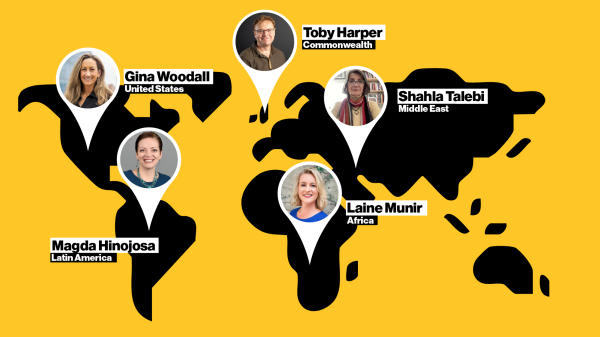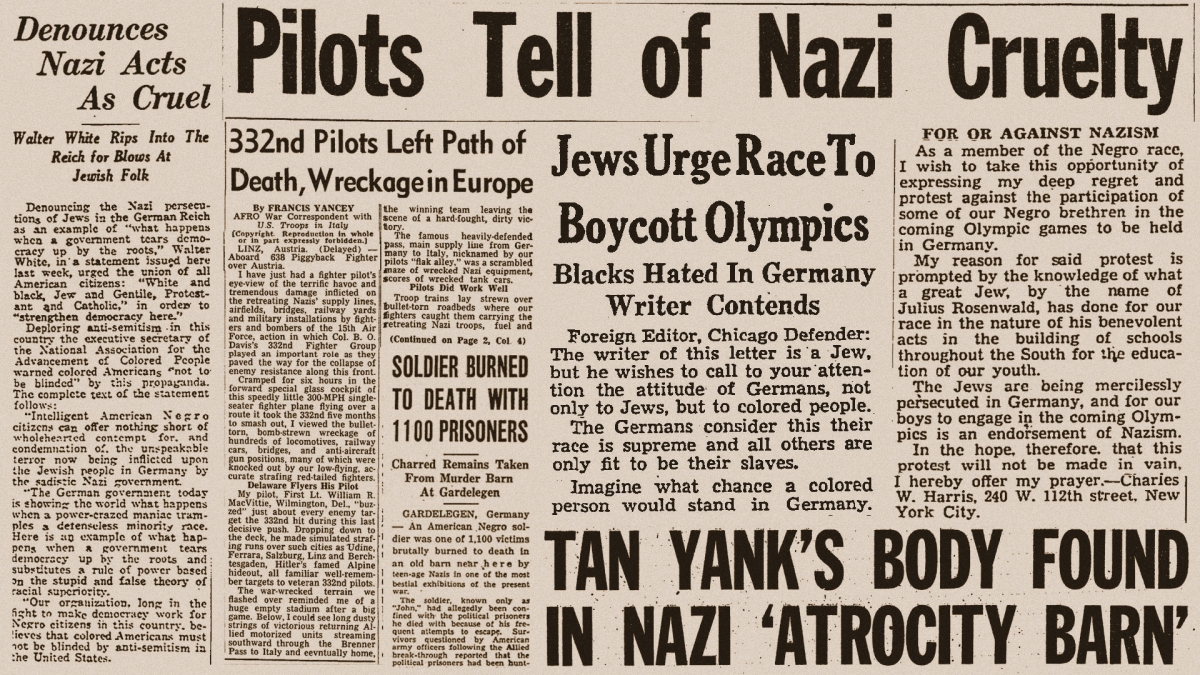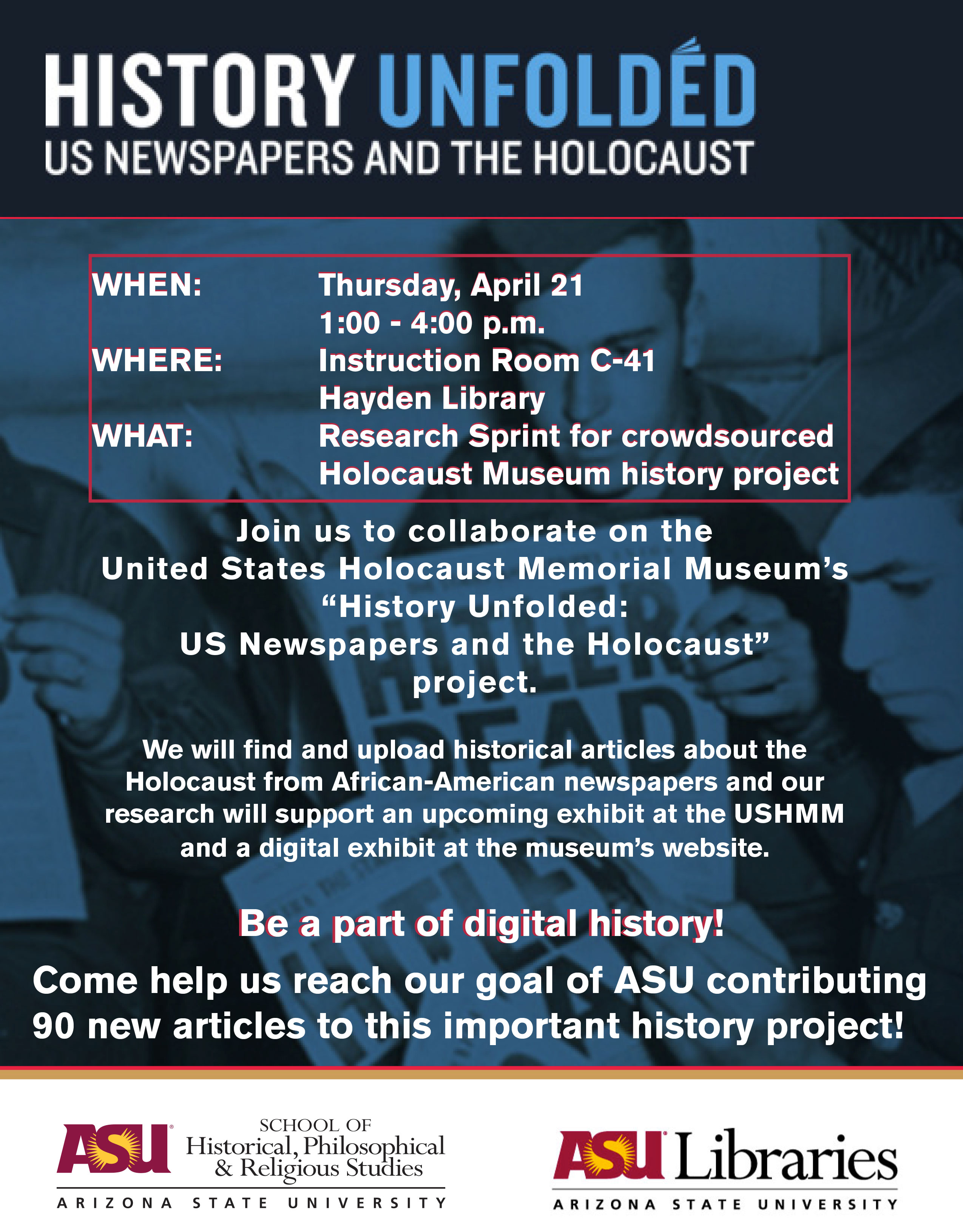The horror that was the Holocaust exists now in our collective consciousness as one of the darkest periods in human history.
However, as Arizona State University associate professor of history Matthew Delmont points out, knowing that it happened from reading about it in a history textbook and seeing firsthand how it played out on a day-to-day basis are two very different things.
The United States Holocaust Memorial Museum’s “History Unfolded: U.S. Newspapers and the Holocaust” project aims to do the latter and — in collaboration with ASU’s School of Historical, Philosophical and Religious Studies and ASU Libraries — is inviting ASU students, faculty and staff to contribute.
This Thursday, April 21, from 1 to 4 p.m., Hayden Library on the Tempe campus will hold a “research sprint” to find historical newspaper articles about the Holocaust using the library’s digital database. The articles will be included in an upcoming exhibit at the Holocaust Museum and in a digital exhibit on the museum’s website.
ASU is the first institution to hold an event supporting this crowdsourced project, and it has set a goal of contributing 90 articles to it.
This particular event will focus on pulling articles from African-American newspapers across the U.S.
Delmont, who specializes in the area, was contacted by the museum’s digital project coordinator to contribute when she stumbled upon a similar project of his on Twitter.
Currently an underrepresented demographic in the project, the addition of African-American newspaper articles will ensure a more well-rounded representation of the average American’s perspective of the Holocaust as it was happening.
To learn more about it, ASU Now sat down with Delmont for a Q&A.
Question: Why did the United States Holocaust Memorial Museum ask ASU to specifically focus on African-American newspapers?
Answer: It’s my research specialty, and it’s an area that is underrepresented in their collection. They’ve crowdsourced just over 1,000 articles so far, and when the digital project coordinator reached out to me, they only had a tiny fraction, like 1 or 2 percent, from African-American newspapers. So they want to make sure that all different communities are represented.
As I started to look around a little bit, I found that the ways in which African-American newspapers were talking about the subject was different than other communities because [African-American newspapers] were often looking at it in relationship to what was going on in America [at the time]. They were sort of trying to draw connections and offer support as a group of people who were encountering some similar types of racial oppression and hatred in the United States. … Even some of the phrasing, talking about some of the murders of Jews in Russia being lynchings. That is a language that comes more from the American South, but they’re trying to get their readers to pay attention to what’s going on globally.
Q: This project relies a great deal on digitally sourced material. How is ASU uniquely capable of contributing to that?
A: They’re going to need as many people as possible to contribute as many articles as possible, and we have a great wealth of information here; we have great resources here. The particular way that ASU is going to be able to contribute is that we have libraries that have access to a digital newspaper database that has digital records of nine African-American newspapers; that’s where our research efforts are going to be dedicated to, primarily. ...
We have both our on-campus students and faculty participating, but also some of our online students because all you need for the project is to have access to ASU’s digital resources. We have a large online history master’s program, so 20 students have already signed up to participate in the event virtually, which will be kind of neat.
Q: What are some of the difficulties with crowdsourcing materials for a project like this, and what are some of the rewards?
A: The Holocaust Museum is calling it a “citizen historian project,” which I like. One of the things that I value as a professional historian is trying to get my students and people outside of the academy to understand what historical research is about. And I think one of the best ways to do that is to dive back into these historical newspapers, because they’re just fascinating.
" ... getting back to those primary sources is valuable for me as a professional historian."
But the research is messy, so in some cases you’ll spend an hour looking for stuff and you won’t find anything. That’s part of the research struggle; you spend a lot of time looking for things and sometimes you don’t find anything. But then when you do come across something, and you see the details with which they’re talking about things … it’s hard to recapture how these events mattered for people in 1935, 1937, 1940, and the kind of connections they were drawing.
One quick example that I found already is the debate about whether the U.S. should boycott the 1936 Olympics that were held in Germany. There were some interesting — and this is what gets into the African-American press — some interesting arguments about whether it was better to send the American athletes, particularly black athletes, to go and sort of demonstrate that America was a more democratic place than Germany, and try to sort of prove Adolf Hitler wrong, or whether it was better to boycott and not partake in that. Because there was some concern that he was going to put on this spectacle showing that Germany was somehow welcoming to all members of the world but in fact it was not. The detail there is just more nuanced than what shows up in our history textbooks today.
So I think getting back to those primary sources is valuable for me as a professional historian. It’s also valuable for students and for people who just have a casual interest in history. It’s just fascinating, the ways in which these things were talked about, and trying to imagine how people learned about these things, this horrible history that we now have a better understanding of but to see how they were learning about it at the time.
Q: Have you found anything surprising?
A: I’ll have a better answer to that after Thursday’s event, after we really dive in. The debates about the Olympic boycott were particularly interesting to me. There was one article about Jewish refugees coming to the United States, and the African-American writer was talking about how the United States might not be that much better of a place, with regards to race and ethnic politics, than what [the Jews] were leaving in Europe. [The U.S.] was certainly a better place compared to what was going on in Germany, but the writer way saying that we shouldn’t hold up the U.S. as a bastion of democracy in this era. So that was interesting.
Then I started looking beyond African-American newspapers to the Hartford Courant [in Connecticut]; we have some other digital newspapers that we have access to as well. What struck me there was how in the late 1930s at synagogues in Hartford, they had prayer services to commemorate what they saw going on in Europe. I can’t imagine there were more than a few hundred people, or maybe just a few dozen people, present. But those kind of events, organizing prayer services ... just reading about it and trying to get a sense of what this news meant to people as they were receiving it … that was valuable.
"Just imagining people opening up their newspapers on that day and reading about it, the kind of shock that must have been there."
And then the most tragic articles are the ones where the reports are coming back, in this case from African-American G.I.’s, about concentration camps and what they had witnessed firsthand. It’s horrific, just reading some of the stuff, even when you know it and you’ve seen the videos, you know the history of what happened. Just thinking back to when it was being reported in 1944 and 1945, for the first time. Just imagining people opening up their newspapers on that day and reading about it, the kind of shock that must have been there.
Q: Why is it important to have these kind of robust, accessible archives that don’t romanticize history?
A: Sometimes it’s easy when — if you think about how history is taught in textbooks — it’s easy to sort of move from one epic event to the next. So we have the Holocaust, we have the end of WWII, we have the Civil Rights Movement. And these things, they’re meaningful but there’s almost a sense that you know it already. I’ve encountered this with students sometimes when talking about the Civil Rights Movement; they’ll say, “Oh, I know this already because we covered it in high school.” Trying to break through that sense of being aware that something happened and being aware of what it meant to people at the time, or being aware of why it matters, or the number of different turning points at which things could have happened differently, are two different sets of ways of understanding history.
I think we are at a pretty good place in terms of awareness that the Holocaust happened. It’s widely taught in high schools, widely taught in colleges, people are aware that it happened. But I think this project has the ability to de-familiarize it in some way, to get people to see all of these different local reactions, including some people who were arguing for and against accepting refugees. That’s hard to read, but that’s the history. And I think that helps to present a fuller picture of the time period that can make it more accessible. ... Maybe it’s an anecdote, maybe it’s an editorial cartoon, maybe it’s someone’s description of this one particular thing and that’s what will help make that larger history more meaningful or resonate with you more.
Q: Some may find the fact that America knew about what was going on with Holocaust to be unsettling. What can we learn from that today?
A: There’s a sense that you think, 'Well, if people just had the information, they would have done something different.' And that’s just emphatically not true. There are reasons why people might not have taken the actions we would have wanted them to take. They had the information [about the Holocaust] as early as 1933. And I think probably what this project shows is that in all of the newspapers across the country, reports about things like the Nuremberg laws, taking Jews’ property, pushing them into ghettos at the start of the concentration camps ... all of that is there.
"People were trying to rally — both within and outside of the Jewish community — to do something about it."
There’s a gap between people being aware that it’s happening and the political motivation, the political will to do something about it. Which I think can help us make sense of our present. We see a lot of atrocities in the news … and that doesn’t necessarily lead to action to fix things, but I think it does help us to see that this was a complicated history that played out over a decade, and that America was very much involved. People were trying to rally — both within and outside of the Jewish community — to do something about it. And there were votes for and against accepting refugee children that echo so strongly with what’s going on in the present. Understanding how this played out on a day-to-day basis as opposed to a 10-page chapter in a history text book, I think that that’s one of the most valuable things we can learn from this.
Q: Do you think there’s a chance that this project will change people’s views about the refugee crisis in Europe today?
A: I think there’s a chance. I mean, I think that the Holocaust is a unique historical event, but there are some lines of continuity we can draw. I think the issues about refugees, both in the U.S. but also in Europe is probably the most direct example. I think most people probably don’t realize that the refugees from Europe during WWII who were fleeing Nazis and fascism were not welcome with open arms in the United States.
I don’t know if that’s going to change people’s minds about the present, but as a historian, I always think if people are at least are aware of what the history actually was, that gives us a fighting chance of doing things better the second time. So I would be hopeful in that regard, but I wouldn’t bet money on it.
Top photo: A collage of news clippings related to the Holocaust.
More Law, journalism and politics

ASU committed to advancing free speech
A core pillar of democracy and our concept as a nation has always been freedom — that includes freedom of speech. But what does that really mean?Higher education doesn’t have an agenda to curate a…

ASU experts share insights on gender equality across the globe
International Women’s Day has its roots in the American labor movement. In 1908, 15,000 women in New York City marched to protest against dangerous working conditions, better pay and the right to…

ASU Law to offer its JD part time and online, addressing critical legal shortages and public service
The Sandra Day O’Connor College of Law at Arizona State University, ranked 15th among the nation’s top public law schools, announced today a new part-time and fully online option for its juris doctor…



